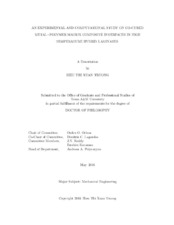| dc.description.abstract | Due to the increasing needs for lightweight and multifunctional materials and structures that can perform in extreme environment such as high temperature and pressure, hybrid composite laminates that are comprised of both metallic and polymeric constituents are under development. Because of the mismatch in properties of different layers in these hybrid laminates, the interfacial regions between polymer and metal are critical for durability and reliability. The objective of this work is to develop a robust and multifunctional interface between metallic foils and carbon fabric reinforced polymer matrix composite (PMC) for hybrid materials that can maintain mechanical properties at high temperature temperature, i.e. up to 200 - 300°C. The major focus of this Ph.D. dissertation is the fabrication and characterization of the high temperature hybrid interface between Ti/NiTi with high temperature thermosetting polymer matrix composites. Approaches derived from experimental techniques for manufacturing and characterizing are utilized. In particular, the highlight of this work is the employment of the novel laser ablation method in combination with a custom-synthesized sol-gel treatment technique to prepare the surfaces of metallic foils for strong adhesion with the polymer matrix composites. The mode I and mode II fracture toughness of the hybrid interfaces is characterized at various temperatures up to the glass transition temperature onset of the polymer matrix. To achieve this, the double cantilever beam (DCB) and four-point end notch flexure (4- ENF) tests were performed. In-situ distributed strain measurements using Rayleigh back-scattered fiber optics and digital image correlation (DIC) are carried out during the fracture toughness tests at both room and elevated temperatures. Extensive characterization of the hybrid interface cross-section is performed using optical microscopy, scanning electron microscopy/energy dispersive spectroscopy and atomic force microscopy/nano-infrared spectra analysis. Other thermal-mechanical characterization methods employed in this work include dynamic mechanical analysis, thermomechanical analyzer, differential scanning calorimetry, and thermal gravimetric analysis. Finite element analyses (FEA) are conducted in parallel with experiments to provide assistance to understanding the fracture behavior of the hybrid metal-composite interfaces. The virtual crack closure technique with mixed-mode fracture criterions is used to model crack propagation in double cantilever beams. The influence of thermal residual stress due to curing on the crack growth at the hybrid interface is investigated. The effect of laser ablated pattern on the fracture behavior of the hybrid interfaces is studied via the extended finite element method (XFEM). | en |


